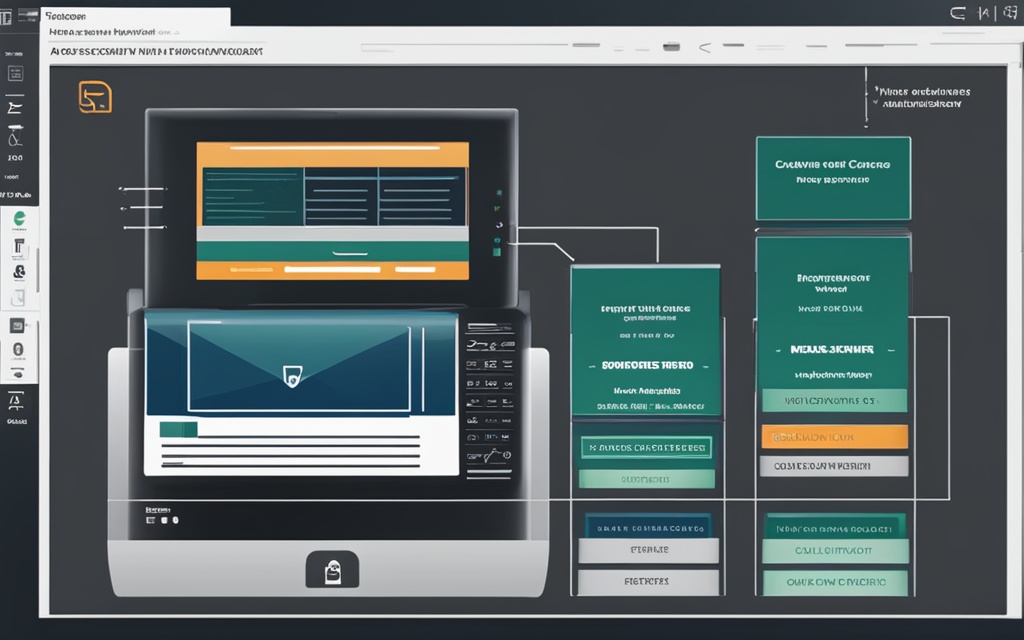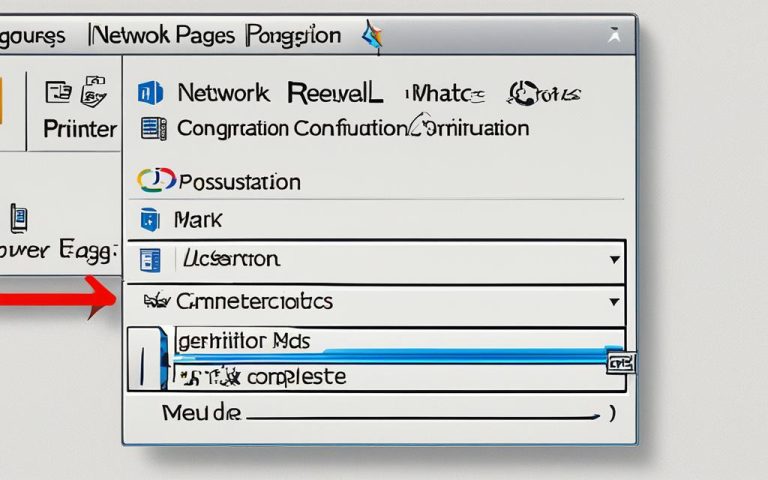Captive Network Assistant (CNA) is a key feature in Apple devices that changes how we connect to public Wi-Fi. It makes joining and logging into networks easy and safe. This means users can surf the web without any hassle.
For people like ArmandoWyo, who’ve faced internet problems with captive networks for years, CNA is a game-changer. Even though iOS fixed a similar issue a few years back, MacOS still has trouble with it1. ArmandoWyo tried turning his computer off and on, or bookmarking the sign-in page on Safari, but nothing worked well1.
The Captive Network Assistant app on MacOS was meant to ask for login details on captive networks. But it didn’t work for ArmandoWyo1. He tried many things to solve the problem, like checking for VPN or security software issues, using diagnostic tools, and making sure Safari’s pop-up blocker wasn’t blocking anything1.
ArmandoWyo finally got his home WiFi to connect automatically, but the captive network issue was still there1. His Mac didn’t find any problems, but the Wi-Fi Recommendations didn’t show up for him either1. This shows that a more detailed solution is needed1.
In places where online activities are watched closely, having a VPN is key for real privacy. It keeps your connection safe from unwanted visitors. With CNA, staying secure on captive networks becomes easier1.
Key Takeaways:
- Captive Network Assistant (CNA) is a built-in feature in Apple devices, aiding users in connecting to public Wi-Fi networks1.
- CNA simplifies the login process, automating the authentication with captive networks and ensuring a secure browsing experience1.
- While MacOS is yet to resolve captive network issues, iOS has previously addressed similar concerns1.
- ArmandoWyo’s experience highlights the need for a comprehensive solution to address captive network challenges1.
- Users benefit from CNA’s secure connection, particularly in countries where online activities are monitored1.
What is Captive Network Assistant?
Have you ever used public Wi-Fi on an Apple device and seen Captive Network Assistant? It’s a tool that helps you connect to open Wi-Fi safely. But what does it do, exactly?
Captive Network Assistant is a built-in tool for iPhones, iPads, and Macs. It makes sure you can connect to open Wi-Fi safely. When you join such a network, it turns on automatically. It acts like a special web browser in your device.
This tool catches the first network request from your device’s web browser. Instead of letting you access the network freely, it shows a captive portal page. This page asks you to do certain things, like agree to terms or log in, before you can use the internet.
This image shows how the Captive Network Assistant works. It acts as a bridge between your device and the open Wi-Fi network.
Enhancing Wi-Fi Security
The main goal of Captive Network Assistant is to make your Wi-Fi connections safer. It stops unauthorized access to open networks by showing a captive portal. This makes your connection to the network secure.
After you complete the web authentication, the Captive Network Assistant closes. This stops any more interactions.
Addressing User Concerns
Even though it’s good for security, Captive Network Assistant has faced some criticism. Users have pointed out some issues.
Some Mac OS X 10.8.x computers had trouble starting the XpressConnect Java applet and downloading network profiles from the Captive Network Assistant2. Users also mentioned the limit on automatic profile downloads when logging in2. Some even turned it off because they didn’t find it useful2.
Users also said it can’t save cookies, which affects browsing2. They found it hard to use the Captive Network Assistant because of missing feature lists and browser workarounds2.
“The Captive Network Assistant seemed pointless. Even after agreeing to the terms, it didn’t offer more benefits. I ended up disabling it.”
Users also pointed out its limited functions, like restrictions on JavaScript, no tabs, and not being able to open Safari from the CNA2.
To get around these issues, users tried using other browsers or site-specific browsers2. Some even used third-party tools like Fluid to make site-specific browsers for easy access to captive portals2.
Even with its limits, the Captive Network Assistant is crucial for making Wi-Fi connections simpler and safer3. It guides users through the steps needed and makes the process clearer for Apple device users3.
Next, we’ll look into how it works and why it’s important for Wi-Fi security.
Importance of Captive Network Assistant
The Captive Network Assistant (CNA) is key to keeping Apple devices safe when using open Wi-Fi. It automatically turns on to secure connections to public Wi-Fi networks4. This feature guards against threats like man-in-the-middle attacks and data theft4. It does this by limiting what you can do online, like downloading files or browsing, to keep your data safe4.
The CNA also helps users understand their internet use better. It shows the terms for each network, making sure you agree to them before using the Wi-Fi4. This makes your browsing clear and safe, as you know what risks you’re taking4. It also teaches you to think about your online actions, promoting safe internet habits.
The CNA is vital for public Wi-Fi spots and company networks too. It makes connecting to Wi-Fi easy and safe for everyone4. It cuts down on the need for logins, saving time for both users and network owners. Plus, it keeps data safe for companies and IoT devices on public Wi-Fi4.
Businesses and Captive Network Assistants
Businesses in many fields gain a lot from using captive network assistants. Places like cafes, hotels, and shopping malls can improve their Wi-Fi with this tech5. By using captive portal software, they offer secure and dependable Wi-Fi to their customers5.
For businesses like restaurants and hotels, having good Wi-Fi is a must. Guests often use many devices, so the CNA makes it easy for them to get online quickly5. This means less work for staff and happier guests, making the business run smoother5.
Good Wi-Fi can also make or break a business’s image. Offering secure and fast Wi-Fi can make customers happier and more likely to return5. A smooth internet experience can make a big difference, boosting customer satisfaction and loyalty5.
How Captive Network Assistant Works
When an Apple device connects to an open Wi-Fi network, the Captive Network Assistant (CNA) steps in. It shows a captive portal page that needs the user to take certain actions6. This could be agreeing to terms, logging in, or paying for access6. After the user does these things, the CNA knows they’ve been authenticated and lets them use the internet freely6.
The CNA Bypass feature makes things easier for new employees6. It skips the CNA interface, saving time and making things more efficient6. This means users don’t have to deal with the CNA, making their experience better6.
Also, the CNA Bypass helps keep organizations secure while offering flexibility6. It works with many devices and systems, helping all kinds of organizations6. With this feature, setting up software and security is easier, even with the CNA’s limits6.
Captive Network Assistant Statistics
| Created | Replies | Boosts | Views | Participants |
|---|---|---|---|---|
| Jul ’15 | 5 | 0 | 6.7k | 5 |
The Captive Network Assistant has been key in managing Wi-Fi connections for Apple devices for years6. It keeps getting better, with features like the CNA Bypass making it easier to set up devices6. This tech makes getting devices ready for work faster and safer6.
The CNA has a big community, with lots of discussions and resources7. It has 1.7K topics, 10 items in the Library, and 24 blogs7. With 419 members, it’s a place where people share tips and help each other out7.
Enhancing Security with Captive Network Assistant
Captive Network Assistant (CNA) is key to making Apple devices safer when using open Wi-Fi networks8. It stops users from accessing dangerous sites, limits downloads, and controls browsing. This reduces the chance of data theft and keeps sensitive info safe8. CNA also shows pages with terms and conditions, making users aware of the network they’re on. This promotes safe and informed internet use8.
CNA’s strong security features give users peace of mind, protecting them from cyber threats on unsecured Wi-Fi networks. It’s great for businesses, schools, and public Wi-Fi spots. By using capture portals and things like usernames and passwords, CNA makes networks safer and keeps user info secure8. This is especially useful in places like offices, schools, and public spots like cafes and airports89.
Adding AI and ML to capture portals makes CNA even better8. These techs can check network traffic, spot oddities, and find security risks fast89. This means CNA can beat new threats, keeping data safe and networks secure89.
Benefits of Captive Network Assistant
| Benefits | Description |
|---|---|
| Increase WiFi’s security | Captures potential security breaches and limits unauthorized access10 |
| Collect marketing information | Gathers valuable user data for targeted marketing campaigns810 |
| Keep customers happy | Enhances user experience by ensuring secure and informed internet usage10 |
As tech gets better, capture portals will use blockchain and better encryption for more security8. They’ll also get easier to use, thanks to better design and NLP for smoother interactions8.
Capture portals are becoming more popular in different fields, showing their wide value8. They’re used in healthcare, finance, education, and government, making things safer and improving customer satisfaction9. By securing networks in places like cafés, hotels, airports, and schools, CNAs give peace of mind to everyone, ensuring a safe internet experience9.
Benefits of Using Captive Network Assistant
Using Captive Network Assistant offers many advantages. It ensures secure connectivity by linking devices to a safe network. This protects data from threats. It also makes browsing smooth by automating logins, cutting down on manual efforts.
This saves time and reduces frustration for users.
“CPMBs were developed and added to devices back in 2014 to enhance security, interaction, and usability for public WiFi hotspot users.”11
It’s especially useful for businesses. It gives secure and easy access for employees and guests. Plus, it boosts IoT device connectivity in our connected world.
Streamlined Setup and Authentication
Setting up Captive Network Assistant is easy with pre-configured templates and a drag-and-drop template editor. This cuts down setup time for operators. The upload stylesheet feature makes creating login pages simple.
“ANTlabs captive portal login pages are easy to set up with pre-configured templates, drag-and-drop template editor, and the upload stylesheet feature, significantly reducing setup time for operators.”11
ANTlabs gateways offer many authentication options for guests. Choices include social media, free access, and more. This makes it easy for guests to connect.
“There are various authentication options available for guests connecting through ANTlabs gateways, such as social media, complimentary access, user ID & password, access code, MAC-level, PMS authentication and billing, email, SMS, Office 365, auto-login, credit card, account printer, etc.”11
Logging in through social media on the captive portal lets users access public data. This gives operators insights to improve user experiences.
“Users logging in via social media on the captive portal authorize access to data marked as public, providing operators with insights to tailor experiences based on user demographics.”11
Enhanced Monitoring and Insights
Captive Network Assistant lets operators use ANTlabs Cloud Service (ACS). This gives drill-down reports on user data and network health across sites. Operators can check network performance and make informed decisions from anywhere.
“ANTlabs Cloud Service (ACS) provides drill-down reports on user demographics and network health across multiple sites, enabling operators to monitor network performance remotely.”11
ANTlabs gateways also offer seamless relogin and global roaming. This means users can easily log in to WiFi at different locations without entering access codes again.
“ANTlabs gateways offer seamless relogin and global roaming features, allowing users to automatically log in to WiFi across different branches without re-entering access codes.”11
Compliance and Data Privacy
Captive portal login pages are key for getting user consent and protecting businesses from illegal WiFi use. They also meet legal requirements for user data privacy.
“Captive portal login pages are used to collect end-user acceptance and indemnify businesses from illegal WiFi use or comply with regulatory requirements regarding user data privacy.”11
ANTlabs products follow GDPR rules, ensuring user data stays private. Users can manage their data through the ANTlabs portal.
“ANTlabs products are GDPR-compliant, ensuring user data privacy and empowering users to manage their data through the ANTlabs user portal.”11
Evolution of CPMBs and Secure Connectivity
CPMBs have grown to add more security for users. Features like QR code scanning and limiting app interactions keep user data safe.
“CPMBs evolved to add a security layer for users, offering features like QR code scanning and limiting interactions with native apps to protect user data privacy.”11
Captive portals via mini browsers are a common way for users to connect to guest WiFi. This ensures safe connectivity.
“Captive portals via mini browsers remain a common and accessible mechanism for users to sign on to guest WiFi networks, ensuring safe connectivity.”11
Hotspot 2.0 offers a secure roaming solution without captive portals. But, it needs more adoption to ensure safe WiFi connectivity for everyone.
“Hotspot 2.0 provides a secured roaming solution without captive portals, but widespread adoption is needed to ensure safe WiFi connectivity for all users.”11
The Benefits Outweigh the Inconvenience
The advantages of captive portals for guest WiFi networks outweigh the potential inconvenience for both operators and users.
“The benefits of captive portals for guest WiFi networks outweigh the potential inconvenience for both operators and users.”11
Troubleshooting Captive Network Assistant Issues
Users may face issues with Captive Network Assistant that affect their experience. It’s key to understand and fix these problems for smooth connectivity.
Here are some steps to help with Captive Network Assistant issues:
- Authentication errors: If you can’t connect, check your Wi-Fi login details. Make sure you enter the username and password correctly12.
- Connectivity issues: Sometimes, too many devices on the network can cause problems. Try restarting your device and check your network settings. This might fix the issue and get you back online12.
- Outdated software: Old software can clash with Captive Network Assistant. Always update your device with the latest software from the manufacturer13.
Organizations may also face unique challenges with Captive Network Assistant. The security features can make it hard to set up networks. It’s vital to work with network admins and IT teams for a smooth setup that fits the security needs13.
Fixing Captive Network Assistant problems needs a step-by-step approach. Each issue might need different solutions. By tackling these problems, you’ll get better connectivity and a smoother experience.
Summary Table: Common Troubleshooting Steps
| Troubleshooting Step | Explanation | Reference |
|---|---|---|
| Authentication errors | Ensure correct usernames and passwords are entered. | 12 |
| Connectivity issues | Restart devices and verify network settings. | 12 |
| Outdated software | Keep devices’ software up to date. | 13 |
| Network onboarding challenges | Work closely with IT teams to navigate security features. | 13 |
Is Captive Network Assistant Safe?
Yes, Captive Network Assistant is safe. It protects devices and data on public Wi-Fi. It connects devices to secure networks and encrypts data to stop others from listening in14.
Companies use captive portals to make sure remote users can connect safely to Wi-Fi. This makes accessing Wi-Fi services smooth14.
The onboarding process is key with Captive Network Assistant. It adds new users to the network and gives them easy Wi-Fi access. This keeps the network safe and stops unauthorized access14.
Captive portals can make special landing pages. These improve brand interaction, network security, and help businesses follow the law14.
Good onboarding is vital for network security. Bad onboarding can lead to security issues, unhappy users, and more network misuse14.
For Wi-Fi onboarding to work well, clear communication is needed. Users must understand the process, terms, and network rules14.
Captive Network Assistants (CNAs) make onboarding for guest Wi-Fi easier and safer. CNAs help users connect securely and smoothly14.
Using hidden SSIDs for onboarding makes connecting easier for new users. It also keeps the main networks safe14.
VLAN segmentation is used to protect data and resources by limiting access. It’s great for schools, universities, and companies to manage networks and protect data14.
In summary, Captive Network Assistant is a safe and efficient way to use public Wi-Fi. It uses security steps during onboarding to keep networks and user data safe14.
Conclusion
Captive Network Assistant (CNA) is a key tool for safe and easy Wi-Fi use. It makes browsing safer by protecting devices from threats15. It also makes connecting to public Wi-Fi simple and secure16.
HTTP cookies are a big security risk, affecting many websites17. Public Wi-Fi spots are also at risk because they use captive portals17.
Even with its perks, CNA has its downsides. Users might find the captive portal hard to use, and it might not work with older devices16. But, using HTTPS encryption and security checks can help protect user info16.
As technology gets better, so will Captive Network Assistant. It will keep helping us surf the web safely on public Wi-Fi15. It’s great for places like hotels, airports, schools, and shops16.
In summary, Captive Network Assistant changes Wi-Fi for the better. It’s easy to use, secure, and can be customized for different places151617. As it grows, CNA will keep being vital for safe and dependable Wi-Fi.
Read more:Apple Developer Forum,SBA Research: Browser-side Web Trackingand Its,WorldWisePro: What is Captive NetworkAssistant
FAQ
What is Captive Network Assistant?
Captive Network Assistant is a feature in Apple devices for secure Wi-Fi connections. It makes joining public Wi-Fi networks easy and safe. It ensures a smooth and secure way to browse the internet.
Why is Captive Network Assistant important?
It’s key for keeping Apple devices safe on open Wi-Fi networks. It stops users from reaching harmful sites and protects against threats like man-in-the-middle attacks. It also makes sure users agree to network terms, offering a secure and clear browsing experience.
How does Captive Network Assistant work?
When an Apple device connects to open Wi-Fi, the Captive Network Assistant steps in. It shows a captive portal page that needs user action, like agreeing to terms or logging in. After the user does this, the Assistant gives full internet access, making the connection smooth.
What are the benefits of using Captive Network Assistant?
It ensures safe connections and protects data from threats. It makes browsing easy by handling logins automatically, saving time and reducing hassle. It’s great for businesses, making it easy for employees and guests to connect securely. It also helps with IoT devices in a connected world.
What are some common issues with Captive Network Assistant and how can they be resolved?
Common problems include wrong usernames or passwords, network congestion, and outdated software. To fix these, try restarting your device, checking network settings, and updating your software. Issues with network setup in companies might also happen due to Captive Network Assistant’s security features.
Is Captive Network Assistant safe to use?
Yes, it’s a safe feature that protects devices and data on public Wi-Fi. It connects to secure networks and encrypts data to stop others from listening in. Just make sure your device’s software is current for the best security.
Source Links
- https://discussions.apple.com/thread/254400603 – How to launch/open Captive Network Assist…
- https://discussions.apple.com/thread/5258403 – Just how limited is the Captive Network A…
- https://support.ruckuswireless.com/articles/000002368 – When should I bypass CNA feature | Knowledge Base
- https://techbombers.com/internet-networking/captive-network-assistant/ – What Is Captive Network Assistant?
- https://beambox.com/townsquare/captive-network-assistant – Captive Network Assistant | Beambox
- https://www.securew2.com/blog/what-is-apple-captive-network-assistant – What Is Apple Captive Network Assistant?
- https://community.arubainstanton.com/communities/community-home/digestviewer/viewthread?MID=487 – How Does Apple CNA works for Guest Users connecting to Aruba Instant ON APs?
- https://masqlaseen.com/what-is-captive-network-assistant/ – What is Captive Network Assistant? A Comprehensive Guide
- https://techspark.blog/captive-network-assistant/ – Captive Network Assistant: Secure And Optimize Your Network
- https://beambox.com/townsquare/a-captive-network – A Captive Network | Beambox
- https://www.antlabs.com/latest-news/are-captive-portal-login-pages-still-necessary/ – Are Captive Portal Login Pages Still Necessary?
- https://forums.macrumors.com/threads/captive-portals-dont-work-in-ventura-13-3-1-a.2390069/ – Captive portals don’t work in Ventura 13.3.1(a)
- https://discussions.apple.com/thread/250721099?page=5 – wifi not working – captive portal login s…
- https://www.securew2.com/blog/wi-fi-onboarding-captive-portal – Wi-Fi Onboarding Captive Portal Best Practices
- https://forums.developer.apple.com/forums/thread/113712 – Captive page very slow | Apple Developer Forums
- https://worldwisepro.com/what-is-captive-network-assistant/ – What is Captive Network Assistant?
- https://publications.sba-research.org/publications/Dabrowski2016Browser.pdf – Browser History Stealing with Captive Wi-Fi Portals



















